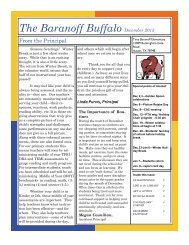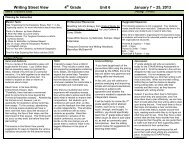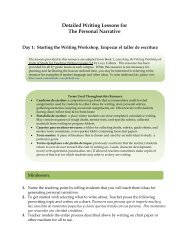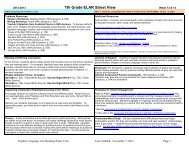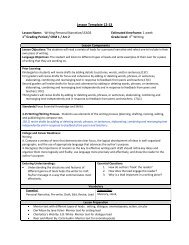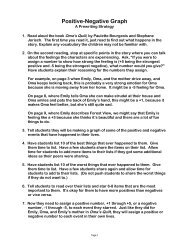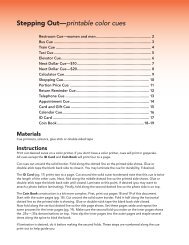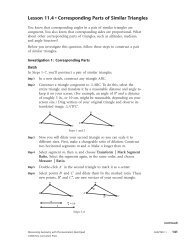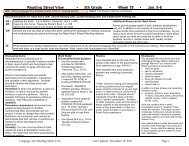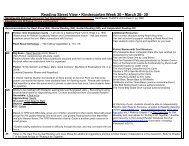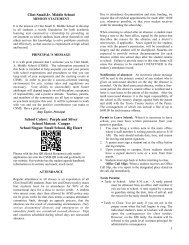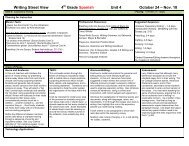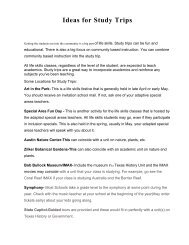Spanish Reading Street View 2nd Grade Weeks 18 & 19 January 7 ...
Spanish Reading Street View 2nd Grade Weeks 18 & 19 January 7 ...
Spanish Reading Street View 2nd Grade Weeks 18 & 19 January 7 ...
- No tags were found...
Create successful ePaper yourself
Turn your PDF publications into a flip-book with our unique Google optimized e-Paper software.
<strong>Spanish</strong> <strong>Reading</strong> <strong>Street</strong> <strong>View</strong> 2 nd <strong>Grade</strong> <strong>Weeks</strong> <strong>18</strong> & <strong>19</strong> <strong>January</strong> 7 - <strong>18</strong>Arc 11: Structure and Elements of PoetryUnit: Understanding Author’s PurposeRecommendations for Read Aloud (RA), Shared <strong>Reading</strong> (SR), Guided <strong>Reading</strong> (GR), and Independent <strong>Reading</strong> (IR)RA /SR:GR:RA: Ningún Dragón para el té, Antología En Voz Alta, p. 17El primer dia de escuela, p. 9Albert’s Play, Read Aloud Handbook, p. 108Véanse los poemas en el libro Géneros Literarios, Unidad 4, pag. <strong>19</strong>-24SR: The Three Bears, Unit 3, pp. 382-384Cucu, Cantaba la RanaTFK Magazine poemas: Corazón Gigante, p. 22, A Pingüinitos, p. 28, Ahi estan! (MirarBallenas), p. 64, El sol, p. 70, La Tortuga, p. 76, Quién ha visto el viento, p. 94,This is Our Earth, p. 88, The Desert is Theirs, p. 102Select poems from above or from poetry anthologies that are appropriate for guided readingfor each group.Additional Resources for Read Aloud:Select favorite poems for both read aloud and shared reading.Some suggestions:The Light in the Attic, by Shel SilversteinDonde el Camino se Corta, por Shel SilversteinConfetti: Poemas para Niños, by Pat MoraIf I Were in Charge of the World, by Judith ViortsJoyful Noise: Poems for Two Voices, Ralph FleischmanIR:Remember that small group instruction should be data driven and focus on students’ deficitskills as measured by the TPRI/Tejas LEE. Teachers plan instruction as appropriate inphonological awareness, phonics, vocabulary, fluency, and comprehension. Use the TPRIInterventions Activity Guide for activities to support instruction in the five components ofreading listed in the previous sentence.Students select poems from their poetry folders and other texts to read during independent reading.<strong>Reading</strong> and rereading poetry during independent reading is a great way to promote fluency.Discussing Genre:Poetry is a genre that lends itself to analysis andinference but be careful about asking students to betoo analytical at first. If students are going to lovepoetry, they need to feel it and enjoy its language first.Poetry provides special opportunities for students asthey build processing skills for reading. Poetry: Supports the engagement of emotions Evokes sensory images, allowing deeper meaning Lends itself to reading aloud and reread becauseof the inherent pleasure takes in its form Incorporated rhyme and rhythm Captures deeper meaning in very few words fromwhich the reader must make inferences Offers opportunities for many interpretationsWord StudyYou may want to readministerthe CorePhonics Survey todetermine instructionalneeds for both whole groupand small group instruction.Introduce new highfrequency words andpractice the words usingWord Wall Activities.See Interactive Word Walls.Fluency: This is a great week forstudents to practice fluency with poetry.If you have not already, introduce atleast one poem a week for students toplace in their poetry folders. Studentswill read and reread poems.Teaching Tip: Use small font on yourcomputer to write and print “pocketpoems” on colored paper. Use pinkingshears to cut out the poems. Introducethe poems to students as special pocketpoems that they can carry in pockets toshare with family and friends. Studentswill love these tiny poems. There is aday in April (poetry month) designated aspocket poem day.VocabularySelect 5-10 tier II words from somepoems you will introduce this week.Introduce the vocabulary as youread the poems.Provide students with studentfriendlydefinitions, questions toprompt students’ oral practice withthe new words, and activities forstudent engagement and practicewith the vocabulary words. Seeactivities below for engagementroutinesVocabulary Activities Using Tier2 Words
Building Comprehension:When reading poetry, read first for meaning and comprehension. Reread a secondtime to look for inferences the poet is trying to convey.Have students pay attention to how the rhythm, rhyme, and repetition interact tocreate images in poetry as stated in the second grade TEKS. Children enjoy rhymeand rhythm and love to do repeated readings of favorite poems, chants, and songs.Also have students look for sensory language in poetry and the imagery created bythis language.Poetry is a vital part of interactive read-aloud time, and poetry workshop is animportant part of the language and literacy framework. Students enjoy making theirown personal poetry anthologies, reading and evaluating poems.The important thing to remember in teaching poetry is to enjoy the language and theimages and emotions that the words evoke. Students enjoy reading and rereadingpoems aloud because of the feelings they generate and/or because of the rhythmand beat.Comprehension/ Discussion Questions:¿Cómo te hace sentir el poema?¿Cuáles palabras interesantes utiliza el poeta?¿Acerca de qué te preguntas en el poema?¿Hay algunas palabras que hagan imaginar algo en tu mente?¿Qué podría estar intentando decirnos el poeta que directamente no lo dice?¿Qué es lo que te gusta acerca del poema? ¿Por qué?¿Cuales palabras que riman vemos y oímos en el poema?¿Qué tipo de ritmo tiene el poema?21 st Century Learning:MEDIA LITERACY: Create Media Products- Understand and utilize the mostappropriate media creation tools, characteristics and conventionsWorking with rhyming helps both with building fluency and developingcomprehension. Check these sites for online practice.The Cream Cake Mystery is a good site for kids who need practice with rhyming. Itmight be a bit simple for some. In that case, you can use Splatter PoetryAnchors of Support for Independent Student Work: Post some favorite short poems around the room and mark the rhymescheme with letters/circle rhyming words using different color markers. Identify and post sensory language that you discuss as a class whenreading poetry. Include the images that the students discuss (picturesin their minds). Collect similes, metaphors, alliterations as literary devices that are oftenincluded in poems.Teacher Tips: In order to familiarize students with poetry, ask your administrators if poetry could be included weekly in the morning message. Teachers and studentscould take turns reading poems once or twice a week.Smithsonian Poetry Activities offer a variety of complete lesson plans for working with poetry in 2 nd <strong>Grade</strong> classrooms.
<strong>Reading</strong> <strong>Street</strong> <strong>View</strong> 2 nd <strong>Grade</strong> <strong>Weeks</strong> 20 & 21 <strong>January</strong> 22 – February 1Arc 12: Structure and Elements of DramaUnit: Understanding Author’s PurposeRecommendations for Read Aloud (RA), Shared <strong>Reading</strong> (SR), Guided <strong>Reading</strong> (GR), and Independent <strong>Reading</strong> (IR)RA /SR:GR:RA/SR: Obras en la Antología En Voz Alta:Lugar para alguien más, p. 158, La canción secreta, p. 205, Seré El Dragón, p. <strong>19</strong>2, UnaNoticia Tamaño Ballena, p. 206, En busca del lago mágico, p. 165, Mamá Ganso al Rescate,p. <strong>18</strong>0Hormiga y Saltamontes, Unidad 6, p. 390Use any of the dramas listed above or other Reader’s Theater plays, as appropriate, duringguided reading for each group.Additional Resources for Read Aloud:Véase Dramas en libro de Géneros Literarios, pp. 37-111Reader’s Theater Scripts for second grade studentsMore Ideas and Scripts for Reader’s TheaterIR:Remember that small group instruction should be data driven and focus on students’ deficitskills as measured by the TPRI/Tejas LEE. Teachers plan instruction as appropriate inphonological awareness, phonics, vocabulary, fluency, and comprehension. Use the TPRIInterventions Activity Guide for activities to support instruction in the five components ofreading listed in the previous sentence.After students read for about 20 minutes in independent level texts, have them select one familiar story and complete a story map to retell the plot.Discussing Genre:Word StudyFluency:Vocabulary:Plays have been a source of pleasure forreaders for a very long time. A script can becomposed from the dialogue and narrativeof a text. Many children’s books can easilybe written as a play or reader’s theaterperformance.Have students listen for elements ofdialogue such as characterization, conflict,foreshadowing.Have students construct their own learningaround the structure and elements of dramaas they read and discuss a play duringshared reading. Press students to explaintheir thinking ( think-pair-share, turn-andtalk, whole group)Resources:Weekly Spelling Routines and PhonicsRoutines are included in the Tesoros T.E.There are additional resources on the TesorosCD.Note also that the “Prepare” section of theT.E. provides additional suggestions forteaching the Phonics/Word Study patterns.Another Word Study tip:Use index cards or sentence strips. Studentsfold them and cut out small squares orrectangles. Instruct students to write specificconsonants and vowels (patterns you arestudying) for a “Making Words” activity.Making and Sorting Words DirectionsReader’s Theater is a great way topractice fluency for students of allreading levels. Choral reading canbe used for students to becomefamiliar with a script. The emphasisshould be on the interpretation oftext through the voice. Choralreading pro0vides an enjoyableexperience with written language forreaders of any age.Another Fluency Tip:When reading a drama as a choralread, the class may be divided upby character (and narrator) andread in unison with others in theclass.Select 5-10 tier II words fromone or two dramas you willintroduce this week. Introducethe vocabulary as you read thedramas or plays.Provide students with studentfriendlydefinitions, questions toprompt students’ oral practicewith the new words, andactivities for studentengagement and practice withthe vocabulary words. Seeactivities below for engagementroutinesVocabulary Activities UsingTier 2 Words
Building Comprehension:<strong>Reading</strong> dramas or plays allows children to experience a text in another way, one thatprovides authentic purpose for oral reading. It engages and motivates students. Alwayshave students read the play first for meaning and understanding. Ask students questions tosupport their understanding of the plot of the story and to support understanding of thecharacters – their traits, motives, actions, interactions, and changes they undergo. Alwaysask students for text evidence to support their thinking.Reader’s theater is a way of practicing dramatic performances. Students each have a copyof the script and agree who will read (or are assigned) each part (after the entire play hasbeen read and discussed as stated above). After practice, students perform the reader’stheater for an audience. Through reader’s theater, all students: Study characters in order to use the voice to interpret feelings Develop ease with new vocabulary words and language structures by using them in therole of characters or a narrator Practice fluent, expressive reading Pay close attention to phrases and all elements of fluent reading Self-assess their own reading performanceComprehension/ Discussion Questions:¿Qué personajes ha presentado el autor?¿Dónde está el lugar en que se lleva a cabo la historia/ obra? ¿Cómolo sabes?¿Quién crees que es el personaje principal? ¿Por qué?¿Qué ha pasado hasta ahora en la historia/ obra?¿Cuál es el rol que el autor desempeña (si es apropiado)?¿Qué información está siendo proveída en las direcciones de escena?¿Cómo es la obra similar/ diferente de la historia? ¿Qué tiene la obraque no tiene la historia típica?¿Cuál es el principal conflicto en esta obra?¿Qué tipo de persona es __? ¿Cómo lo sabes?¿Cómo está cambiando el personaje?¿Qué puedes decir acerca de __ que el autor no nos dijo realmente(inferencia)? ¿Qué te hace pensar eso? Build self-confidence through reading for an audience Build oral expression and speaking skills Strengthen their word analysis skills Practice meaningful reading Practice reading loudly and clearlyReader’s theater is especially effective for ELLs, who need opportunities to read and rereadthe syntax of their second language.21 st Century Learning:COMMUNICATION AND COLLABORATION: Communicate Clearly- Communicateeffectively in diverse environments (including multi-lingual); Collaborate with Others-Demonstrate ability to work effectively and respectfully with diverse teams; Exercise flexibilityand willingness to be helpful in making necessary compromises to accomplish a commongoal; Assume shared responsibility for collaborative work, and value the individualcontributions made by each team member.Anchors of Support for Independent Student Work: Post an enlarged piece of a drama that includes elements:title, script, cast of characters, stage directions, dialogue.Discuss why each element is important. Post and refer to criteria for fluent, expressive reading.Teacher Tips: You can easily create reader’s theater scripts from favorite stories or trade books. 1. Select an appropriate text. 2. Select characters and a narrator. 3.Decide the parts to turn into dialogue and narrative. The narrator introduces the story and adds important information to move the story forward. Two to six characterswork well.
<strong>Reading</strong> <strong>Street</strong> <strong>View</strong> 2 nd <strong>Grade</strong> <strong>Weeks</strong> 22 & 23 February 4 - 15Arc 13: Informational Text – Writing to InfluenceUnit: Understanding Author’s PurposeRecommendations for Read Aloud (RA), Shared <strong>Reading</strong> (SR), Guided <strong>Reading</strong> (GR), and Independent <strong>Reading</strong> (IR)RA /SR:GR:IR:RA/SR: Clic, Clac, Muu, Unit 3, 392-417¡Sé listo para Jugar! TFK, pp. 8-10Nivel Inicial: Los ungüentosA nivel: Los ungüentosNivel Avanzado: Para que es Buena la Cabra?ELL: Knitting FeverIf the texts above are not appropriate for your students, select leveled texts from campusliteracy library. Remember that small group instruction should be data driven and focus onstudents’ deficit skills as measured by the TPRI/Tejas LEE. Teachers plan instruction asappropriate in phonological awareness, phonics, vocabulary, fluency, and comprehension.Use the TPRI Interventions Activity Guide for activities to support instruction in the fivecomponents of reading listed in the previous sentence.Additional Resources for Read Aloud:The textbook resources do not have many persuasive texts forsecond grade students. Below are some trade books that aremeant to persuade.A Bargain for Francis, HobanCan I Have a Stegosaurus, Mom? GramblingQuerido Salvatierra, JamesFlossie and the Fox, McKissackLa Verdadera Historia de los Tres Cerditos, Scieszka1. Alexander y el Día Terrible, Horrible, Espantoso,Horroroso , ViorstEarrings, ViorstDiscussing Genre:In persuasive genres, the primarypurpose is to influence the targetaudience’s ideas or behavior. Studentsdeepen their understanding of point ofview by learning how to: Identify each author or speaker anddescribe his or her argument.Students define the speaker’spurpose, consider her reasons, andlook for evidence of bias. Compare details and look forconflicting views. Students look forinconsistencies in how differentauthors describe people and events,consider what’s missing in eachargument, and make inferencesacross sources. Make careful notes on each source.Students organize their notes tocompare different points of view.Word Study:Resources:Weekly Spelling Routines and PhonicsRoutines are included in the TesorosT.E. There are additional resources onthe Tesoros CD.Note also that the “Prepare” section ofthe T.E. provides additionalsuggestions for teaching thePhonics/Word Study patterns.Select word study, spelling andgrammar focus appropriate for wholegroup instruction.Fluency:Resources:Use the Tesoros ApproachingReproducibles, Beyond Reproducibles,and Practice Book (Tesoros CD) toselect the appropriate fluency passagefor your students.An excerpt from each passage can befound on the Tesoros CD, FluencyTransparencies, for teaching fluencytechniques.Another Fluency Tip:Have students read and rereadpersuasive text to convince theiraudience to agree with their stance ona topic.Vocabulary:Resources:Introduce the vocabulary for eachselection using theVocabulary/Comprehension passagepreceding each main selection in theTesoros TE.See the Vocabulary Routine in thepages following each main selection.The routine includes student friendlydefinitions, questions to promptstudents’ oral practice with the newwords, and activities for studentengagement and practice with thevocabulary words.Another Vocabulary Tip:Vocabulary Activities Using Tier 2 Words
Building Comprehension:Have students read persuasive pieces first for meaning. Then have them worktogether to construct their own learning about what writers to do persuade.Students may notice that the authors try to appeal to the audience in differentways. Have student locate and discuss the language that the authors use to try topersuade readers. Below are some additional online persuasive text examples.¿Por qué los autores utilizan lenguaje persuasivo?Propósitos:• Apoyar una causaComprehension/ Discussion Questions:¿Cuál fue el propósito del autor al escribir este texto?¿Qué rasgos textuales son resaltados en el texto persuasivo (si hay alguno)?¿Cómo son los textos persuasivos diferentes de los textos de instrucción?¿Qué postura está tomando el autor acerca del tema ?¿Qué lenguaje utiliza el autor para convencer o persuadirnos acerca de su idea?¿Como apoya el autor sus hechos y opiniones?• Alentar a la gente a actuar• Hacer un cambio• Probar que algo es erróneo• Promover simpatía• Crear interés• Conseguir que la gente esté de acuerdo contigoIn persuasive text, the author tries to persuade the reader by giving goodreasons. Then the author gives facts and examples to support the reasons. Theauthor explains why the topic is important. At the end of a persuasive text, thewriter asks the reader to agree or to act.Muestra de escritura persuasiva with explanations.Por qué la gente no debería ver mucha televisiónPor qué los estudiantes deberían comer desayuno todos los díasPor qué la gente debería ejercitarsePor qué la gente debería leer por placer21 st Century Learning:COMMUNICATION AND COLLABORATION: Communicate Clearly- Listeneffectively to decipher meaning, including knowledge, values, attitudes andintentions;Use communication for a range of purposes (e.g. to inform, instruct,motivate and persuade)Anchors of Support for Independent Student Work: Create a chart identifying specific elements/ features of persuasive texts.Select or write a piece of persuasive text on a chart to post. Use stickynotes to label what the author is trying to persuade the reader to do orthink and how the author uses language to influence the reader.Teacher Tips: To make learning relevant about persuasive writing, have students brainstorm about and discuss somewhat controversial topics that are relevant to thestudents in your classroom. Some ideas might include: standardized testing, school uniforms, serving “unhealthy” food in school cafeterias, have recess versusorganized WOW time, assigning homework, parents allowing them to watch PG 13 movies, etc.
<strong>Reading</strong> <strong>Street</strong> <strong>View</strong> 2 nd <strong>Grade</strong> <strong>Weeks</strong> 24 & 25 February <strong>19</strong> - March 1Arc 14: Understanding and Writing Procedural TextsUnit: Understanding Author’s PurposeRecommendations for Read Aloud (RA), Shared <strong>Reading</strong> (SR), Guided <strong>Reading</strong> (GR), and Independent <strong>Reading</strong> (IR)RA /SR:GR:RA/SR: How to Make a Book Cover, Genre Studies, Unit 5, p. 26A platicar sobre el cuento, Generos Literarios, pag. 38Haz una Piñata, Unit 3, 450-451El arroz con frijoles de Rosa Maria, Unidad 4, 164-167Fresco y Frutal, TFK, p. 40De la Semillas a los Frijoles, TFK, p. 46Seguridad contra Incendios, Unidad 4, p. 80Select texts from campus leveled library or from Macmillan McGraw Hill guided reading setsthat are appropriate for each of your groups.Additional Resources for Read Aloud:El Piñatero, por George AnconaEverybody Needs A Rock, by Byrd BaylorHow to Make Candy Kiss Roses (online recipe)Remember that small group instruction should be data driven and focus on students’ deficitskills as measured by the TPRI/Tejas LEE. Teachers plan instruction as appropriate inphonological awareness, phonics, vocabulary, fluency, and comprehension. Use the TPRIInterventions Activity Guide for activities to support instruction in the five components ofreading listed in the previous sentence.IR:Be sure to make time for student-teacher independent reading conferences to make sure students are selecting and comprehending appropriate texts.Discussing Genre:The purpose of a procedure is to tell thereader how to do or make something.The information is presented in a logicalsequence of events, which is broken upinto small sequenced steps.Procedural texts include instructions,lists, recipes, science experiments andrules for games.Directions include: Goal: where you want to go Steps: the steps needed to get toyour goalInstructions: Instructions are used toWord StudyResources:Weekly Spelling Routines and PhonicsRoutines are included in the TreasuresT.E. There are additional resources onthe Tesoros CD.Note also that the “Prepare” section ofthe T.E. provides additionalsuggestions for teaching thePhonics/Word Study patterns.Select word study, spelling andgrammar focus appropriate for wholegroup instruction.Teaching Tip: Students with symbolmemoryproblems learn better when thehands are involved in tracing, writing, ormoving letters around. “What firestogether stay hard-wired.” (fromFluency:Resources:Use the Tesoros ApproachingReproducibles, Beyond Reproducibles,and Practice Book (Tesoros CD) toselect the appropriate fluency passagefor your students. Teach your studentsto help each other determine theirfluency rate and answer thecomprehension questions.An excerpt from each passage can befound on the Tesoros CD, FluencyTransparencies, for teaching fluencytechniques, UnitVocabulary:Resources:If using a textbook selection, Introducethe vocabulary for each selection usingthe Vocabulary/Comprehensionpassage preceding each main selectionin the Tesoros TE. Teachers mayselect Tier 2 words from trade booksand introduce the vocabulary in contextduring the first read aloud.See the Vocabulary Routine in thepages following each main selection (oruse activities such as the ones linkedbelow). The routine includes studentfriendly definitions, questions to promptstudents’ oral practice with the newwords, and activities for studentengagement and practice with thevocabulary words.
make or do something. Instructionsinclude recipes and scienceexperiments and includes the followingstructure: Goal: what you want to achieve Materials/Ingredients: list what youwill need to achieve your goal Steps: sequence the steps needed.LETRS, Module 3, p. 7).Students need multiple exposure tonew words in order to truly learn them.See Vocabulary Activities Using Tier2 Words for routines for applying newvocabulary words each week.Instructions often include many actionverbs and are written in present tense.Building Comprehension:Have students read procedural pieces first for meaning. Then have them worktogether to construct their own learning about the characteristics and features ofprocedural texts. Some things they may notice:Types of Procedural TextsTexts that instruct how to do a particular activity - recipes, rules for games,science experiments, road safety rules, how to do it manuals.Texts that instruct how to operate things - how to operate an appliance, amachine, the photocopier, the computerFeaturesA procedure usually has four components:Goal or Aim: states what is to be doneMaterials: listed in order of use and includes items needed to complete taskMethod: a series of stepsEvaluation: how the success of the procedure can be tested21 st Century Learning:CRITICAL THINKING AND PROBLEM SOLVING: Reason Effectively- Usevarious types of reasoning (inductive, deductive, etc.) as appropriate to thesituation.Comprehension/ Discussion Questions:¿Cuál es el propósito del autor al escribir este texto?¿Cuál es el tema ?¿Cuáles son las formas en las que el autor presenta la información sobre estetema ?¿Qué rasgos están incluidos en el texto?¿Qué tan claras son las instrucciones/ indicaciones/ explicaciones del autor?¿Por qué piensas eso?Anchors of Support for Independent Student Work: Write procedural texts on a large chart and include common features(caption, illustration, numbered steps, labels. Post a list of topics for procedural texts read. Post procedures for real-life situations – such as how to call 911 in anemergency.Teacher Tips: One of the best ways to teach students about procedural texts is to have them write their own after studying many examples of mentor texts. Studentsmay want to write a favorite snack recipe or directions for how to play a game or other activity.
<strong>Reading</strong> <strong>Street</strong> <strong>View</strong> 2 nd <strong>Grade</strong> <strong>Weeks</strong> 26 & 27 March 4 - 22Arc 15: Connecting Ideas Across TextsUnit: Understanding Author’s PurposeRecommendations for Read Aloud (RA), Shared <strong>Reading</strong> (SR), Guided <strong>Reading</strong> (GR), and Independent <strong>Reading</strong> (IR)RA /SR:GR:IR:RA/SR: Casa del Árbol para Todos, TKF p. <strong>18</strong> y Hogar, Dulce Hogar, p. 20Nuestro Amigo Chimpancé, TFK, p. 24 y Detrás de la Manada, TKF, p. 26Pollito Chiquito y Conejo Tontuelo, Unidad 4, 170-171Arroz con Frijoles… y unos Amables ratones, Unidad 4, p. 132 yThe Elves and the ShoemakerUn Viaje para ayudar, Unidad 4, p. 88 y En la Sala de Urgencias, p. 90La seguridad en la Escuela, Unidad 4, p. 52 y el Oficial Bucle y Gloria, Unidad 4, p.54Nivel Inicial: Seguridad en las RutasA nivel: Seguridad en las RutasNivel Avanzado: Seguridad en las RutasELL: Road SafetyIf the texts above are not appropriate for your students, select leveled texts from campus literacylibrary. Remember that small group instruction should be data driven and focus on students’ deficitskills as measured by the TPRI/Tejas LEE. Teachers plan instruction as appropriate in phonologicalawareness, phonics, vocabulary, fluency, and comprehension. Use the TPRI InterventionsActivity Guide for activities to support instruction in the five components of reading listed in theprevious sentence.Additional Resources for Read Aloud:Compare books by the same author (as in TEK 2.9), forexample:Eve Bunting: The Wednesday Surprise, Night Tree, FlyAway Home, Noche de Humo, Regreso al HogarWilliam Stieg: Amos y Boris, Silvestre y la PiedrecitaMágica, Irene la Valiente, El hueso asombrosoTomie dePaola: Strega Nona, Memo y Leo, La Clase deDibujo, Un Pasito… Y Otro PasitoCelebrate how much students have read this semester. Share a couple of your favorite books read in class (as a model) and then let students share one ortwo of their favorites.Discussing Genre:For making connections acrosstexts, you can use literary orinformational texts. Whendirectly teaching the 2 nd gradeSE, you will need to use literarytexts written by the same authorthat have clear settings and plotsin order to compare – describingsimilarities and differences.This kind of comparison lendsitself to using literature chartssuch as the one shown on theright column of the next page.Word Study:Resources:Weekly Spelling Routines andPhonics Routines are included in theTreasures T.E. There are additionalresources on the Tesoros CD.Note also that the “Prepare” sectionof the T.E. provides additionalsuggestions for teaching thePhonics/Word Study patterns.Select word study, spelling andgrammar focus appropriate for wholegroup instruction.FluencyResources:Use the Tesoros ApproachingReproducibles, Beyond Reproducibles,and Practice Book (Tesoros CD) toselect the appropriate fluency passagefor your students. Teach your studentsto help each other determine theirfluency rate and answer thecomprehension questions.An excerpt from each passage can befound on the Tesoros CD, FluencyTransparencies, for teaching fluencytechniques, UnitVocabulary:Resources:Introduce the vocabulary for each selection usingthe Vocabulary/Comprehension passagepreceding each main selection in the Tesoros TE.See the Vocabulary Routine in the pagesfollowing each main selection. The routineincludes student friendly definitions, questions toprompt students’ oral practice with the new words,and activities for student engagement andpractice with the vocabulary words.Students need multiple exposure to new words inorder to truly learn them. See VocabularyActivities Using Tier 2 Words for routines forapplying new vocabulary words each week.
Building Comprehension:Whether it is connecting to the movies that we watch, connecting to others, orconnecting to the texts that we read, making connections is a natural processthat comes easily to most of us. In teaching, the challenge lies in making ourthinking explicit when we make connections, and teaching our students how toidentify when they are making those connections.In their book, Strategies that Work, Stephanie Harvey and Anne Goudvis state:Generalmente, niños comienzan al hacer conexiones de texto con texto por másobvios elementos de las historias, tales como personajes o problemas. Algunasconexiones de texto con texto para incrementar la sofisticación, podrían incluir: Comparar personajes, sus personalidades, y acciones Comparar líneas del argumento y eventos de la historia Comparar lecciones, temas, o mensajes en las historias Comparar temas, ideas, situaciones en textos apareados de ficción/ noficción Encontrar temas en común, estilo de escritura, o perspectivas en eltrabajo de un autor Comparar el tratamiento de temas comunes por diferentes autores Comparar diferentes versiones de historias familiaresEstrategia para Resumen Narrativo:-Alguien (identifique el personaje(s)-Requerido (describe el objetivo delpersonaje)-Pero (describe un conflicto que estorbe alpersonaje)-Así que (describe como el personajereacciona al conflicto)-Entonces (describe la resolución delconflicto)*Recuerda enfocarte a información que esmás relevanteEstrategia para ResumenExpositivo :-¿Acerca de quien/ qué es el pasajeen su mayor parte?(Tema o materia)-¿Que es importante acerca del temao materia?- ¿Cuándo ocurre esto?-¿Dónde ocurre esto?-¿Por qué es importante el tema o lamateria?-¿Cómo ocurre esto?21 st Century Learning:ICT (Information, Communications and Technology) LITERACY:Apply Technology Effectively- Use technology as a tool to research,organize, evaluate and communicate Information.Powerpoint® is a great tool for organizing students’ thoughts.Have them work in small groups to create a graphic organizer forgathering the connections they find between a pair/ group of texts.Students might also create a web to organize their thinking, usingInspiration ®.Comprehension/ Discussion Questions:Connecting Across Texts:¿Cuál es la idea principal encontrada en ambas selecciones/ historias?La historia y el artículo ambos presentan ideas acerca de _____¿Cómo son los personajes/ argumentos similares/ diferentes en estas dos historias?¿Cuál es el tema en ambas selecciones?What do the lessons in __ and __ have in common?¿Qué tienen en común lecciones en __ y __?¿Cuál es un tema en común en ambas historias?Al comparar __ y __, ¿cuál fue la diferencia de la moraleja en ambas selecciones?Un tema encontrado en ambas historias en [¿o es?] __.¿Cuál oración de la selección nos dice eso __ (inferencia)?Título/Autor Personaje/escenario Problema Eventos SoluciónFly Away HomeGoing HomeAnchors of Support for Independent Student Work:See Literature chart above for an additional anchor for comparing books by the sameauthor.See ORS Module on Connecting Across TextsBoth T-Charts, I-Charts and Venn Diagrams work well to compare texts.Text 1 Text 2Text 1: Text 2:Connections:



